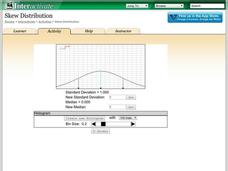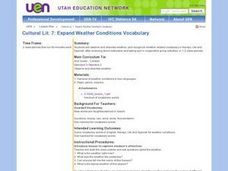Science Friday
How Boulders Are Born
Want your class to rock? Then try this boulder activity. Pupils learn about a specific boulder field and use edible materials to demonstrate the geological processes that formed this unique feature. Weathering, erosion, and mass wasting...
Curated OER
Watercolor Landscapes
Van Gogh's Starry Night and Thomas Cole's The Oxbow are featured in a watercolor lesson that encourages young artists to explore various techniques before creating their own landscape.
NOAA
Tides
Low tides, high tides, spring tides, neap tides, diurnal tides, semidiurnal tides, mixed tides ... just how many types of tides are there? The 10th installment of a 23-part NOAA Enrichment in Marine sciences and Oceanography (NEMO)...
NOAA
A Laboratory Simulation of Ocean Surface Currents
Stimulate interest in ocean currents with a simulation. The first installment of a five-part middle school series teaches future oceanographers about the forces that interact to cause ocean currents. A simulation shows how wind and the...
Western Kentucky University
Understanding Genetics: Punnett Squares
Can scientists really predict genetic outcomes or are they simply making a lucky guess? Scholars first learn about Gregor Mendel and how to make Punnett squares. Then they extract DNA from a strawberry in a lab with included conclusion...
Shodor Education Foundation
Skew Distribution
Slide the class into a skewed view. Learners alter the location of the median relative to the mean of a normal curve to create a skew distribution. They compare the curve to a histogram distribution with the same skewness.
Prestwick House
The Grapes of Wrath
At over 450 pages, John Steinbeck's Pulitzer Prize winning novel The Grapes of Wrath can be a challenging choice for full-class, book circle, or independent reading. The activities in a 10-page sample The Grapes of Wrath activity pack...
Curated OER
Objects in the Sky
Students explore what the sky looks like at different times. They identify objects in the sky and recognize changes over time. Students observe the sky and look for objects that are common in both the daytime and the nighttime sky.
Curated OER
Sky 4: The Moon
Students will draw the moon's shape for each evening on a calendar and then determine the pattern in the shapes over several weeks. Students' understandings should be confined to observations, descriptions, and finding patterns.
Curated OER
Sky 2: Shadows
students will explore making shadows and tracking the movement of an object over the course of a day to look for patterns. It is best to couple this shadow activity with reading the book, Bear Shadow, and making a map of Bear's...
Curated OER
Celt Spoon
Students investigate the invention of a celt spoon. They construct their own in order to make observations. This should include the spinning in opposite directions than that which it is sent. The construction instructions are included in...
Curated OER
Investigating Local Ecosystems
Students investigate the habitats of local plants and animals. They explore some of the ways animals depend on plants and each other. Students observe living organisms in a local ecosystem and create detailed drawings and descriptions...
Curated OER
The Contest Between the Sun and the Wind
Students investigate the relationship between the sun and wind. In this reading comprehension lesson, students read the book The Contest Between the Sun and the Wind, and observe the effect of the Sun and wind on our planet. Students...
Curated OER
Science of Money
Students observe oxidation reaction in the lab using copper pennies. In this chemistry lesson, students examine a $1 dollar bill and record their observations. They explain how to identify counterfeit money using the iodine test.
Curated OER
Reading and Using a Recipe
Students explore how to follow a simple recipe and explain directions to another person.
Curated OER
Discovering Wind
Students discuss what they think wind is before listening to Pat Hutchins, The Wind Blew. Next, the go on a wind walk outside to look for signs of wind using their senses. As they walk, they teacher scribes their observations. The next...
Curated OER
Photograph / Special Object Worksheet
In this fieldwork application worksheet, students utilize a photo or object that they brought to class to study. Then they follow the directions on the worksheet and interview a classmate, using the 13 questions, about his or her photo...
Curated OER
Cultural Lit. 7: Expand Weather Conditions Vocabulary
Second graders study and observe weather. They identify weather related vocabulary in Navajo, Ute, Spanish and English after working in direct instruction and small group activities.
Curated OER
A Tail to Tell
Students observe populations of Lumbriculus to discover some of the adaptations that allow them to live successfully along the shores of ponds and marshes. They also design and perform experiments to test proposed hypotheses for these...
Curated OER
Forces
Fourth graders review the meaning of Newton's 3rd Law and discuss the forces that are acting on a book setting on a table. They draw a diagram of the book on the table and use arrows to illustrate the direction the forces are acting.
Curated OER
Seeing Eye "Buddies"
Third graders observe a variety of sights within their schoolyard habitat and sitting quietly back-to-back with a partner describe what they see. The partner sketches the observations, 3rd graders compare drawings with the object described.
Curated OER
Cranes, Crosswalks, and Big Gulps
Students watch a video and answer questions based on wildlife jobs. In this wildlife lesson plan, students learn that biologists don't just play with animals but that there is a lot of study involved.
Curated OER
Jewish Culture Through Food Recipes
Young scholars engage in studying Jewish culture through the experience of tasting and eating different foods. They answer key questions that are used to guide the lesson. The foods of Americans is contrasted with the Jewish foods.
Curated OER
Chemistry: Mini-Volcanoes
Students observe an experiment using common household chemicals to simulate a volcanic eruption. In small cups, they follow the teacher's instructions to make their own volcanoes. After watching a Brain-pop video, students complete...

























